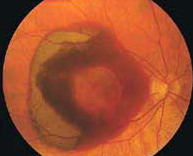
Preliminary results from the highly anticipated Comparison of Age-Related Macular Degeneration (AMD) Treatments Trials (CATT) that tested the effectiveness of Avastin (bevacizumab) versus Lucentis (ranibizumab) in a head-to-head clinical trial are now available.
CATT is a multi-center, prospective trial that has enrolled over 1,200 patients, funded by the National Eye Institute (NEI), a part of the National Institutes of Health.
The first-year results of a two-year study have been published online in the New England Journal of Medicine.
Initial reports indicate that Avastin, a drug approved to treat some cancers and commonly used off-label to treat age-related macular degeneration (AMD), is as effective as the Food and Drug Administration (FDA)-approved Lucentis for the treatment of AMD.
To better understand the function and purpose of both drugs, here is some background information on AMD and drug treatments, including Avastin, and Lucentis:
About Age-Related Macular Degeneration (AMD)
In wet AMD, the choroid (a part of the eye containing blood vessels that nourish the retina) begins to sprout abnormal blood vessels that develop into a cluster under the macula, which is the part of the retina that provides the clearest central vision. This process is known as choroidal neovascularization, or CNV.
Because these new blood vessels are abnormal, they tend to break, bleed, and leak fluid under the macula, causing it to lift up and pull away from its base, damaging the fragile photoreceptor cells, which sense and receive light. This can result in a rapid and severe loss of central vision.
Anti-Angiogenic Drugs
The study of anti-angiogenic drugs has received considerable attention in ophthalmology and cancer research and has been an exciting development in the treatment of wet AMD.
Angiogenesis is a term used to describe the growth of new blood vessels and plays a crucial role in the normal development of body organs and tissue. Sometimes, however, excessive and abnormal blood vessel development can occur in diseases such as cancer (tumor growth) and AMD (retinal and macular bleeding).
Substances that stop the growth of these excessive blood vessels are called anti-angiogenic (anti=against; angio=vessel; genic=development), and anti-neovascular (anti=against; neo=new; vascular=blood vessels).
The focus of current anti-angiogenic drug treatments for wet AMD is to reduce the level of a particular protein (vascular endothelial growth factor, or VEGF) that stimulates abnormal blood vessel growth in the retina and macula; thus, these drugs are classified as anti-VEGF treatments.
At present, these drugs are administered by injection directly into the eye after the surface has been numbed. The needle is very small and is inserted near the corner of the eye — not the center. During the injection procedure, the doctor will ask the patient to look in the opposite direction to expose the injection site, which also allows the patient to avoid seeing the needle.
Avastin
Avastin is an anti-VEGF drug that is FDA-approved since 2004 for intravenous use in colorectal cancer. It is currently used on an “off-label” basis (i.e., via eye injection) to treat wet AMD. The cost per treatment with Avastin is approximately $50.
Lucentis
Lucentis was derived from a protein similar to Avastin, specifically for injection in the eye to block blood vessel growth in AMD. In 2005, clinical trials established Lucentis as highly effective for the treatment of wet AMD. The FDA approved Lucentis in 2006. The cost per treatment with Lucentis is approximately $1,200-$2,000.
Note: The CATT study tested both monthly dosing, used in Lucentis trials, and dosing as needed (called pro re nata, or PRN), used in Avastin treatment for AMD.
About the CATT Study
From Ranibizumab and Bevacizumab for Neovascular Age-Related Macular Degeneration: The CATT Research Group in the New England Journal of Medicine:
In 2005, clinical trials established the efficacy of Lucentis (ranibizumab) for the treatment of neovascular age-related macular degeneration (AMD), the leading cause of legal blindness in the United States. While awaiting approval for [Lucentis] from the Food and Drug Administration, ophthalmologists began treating neovascular AMD with off-label use of Avastin (bevacizumab), since the drug had a target specificity similar to that of [Lucentis] and was available at low cost.
Because the intraocular safety of [Avastin] and the duration of its therapeutic effect were unknown, the drug was usually administered only when there were signs of active disease (i.e., as needed). [Avastin] is the most commonly used drug in the United States for the treatment of neovascular AMD, despite the absence of large-scale clinical-trial data supporting its use. Also, an as-needed regimen has been widely adopted for [Lucentis], a departure from the monthly regimen that was used in the pivotal trials of this drug.
In the randomized Comparison of Age-Related Macular Degeneration Treatments Trials (CATT), we set out to assess the relative efficacy and safety of [Lucentis] and [Avastin] and to determine whether an as-needed regimen would compromise long-term visual acuity, as compared with a monthly regimen.
Study Results
The CATT study revealed equal effectiveness of both Lucentis and Avastin in the management of AMD at one year. The two drugs had equivalent effects on visual acuity at all time points throughout the first year.
A monthly dosing schedule with either drug yielded greater visual gains than PRN (as needed), but the PRN schedule still gave patients substantially improved vision. Lucentis led to a greater reduction in fluid under the retina, requiring slightly fewer PRN injections.
Rates of death, myocardial infarction (heart attack), and stroke were similar for patients receiving either Avastin or Lucentis.
The proportion of patients with serious systemic adverse events (primarily hospitalizations) was higher with Avastin (23%) than with Lucentis (19%). However, the researchers were not able to definitely link these adverse events to the treatments, because the events varied broadly and were in a population with a median age over 80.
Sources: Comparing Treatments for Age-Related Eye Disease; NIH study finds Avastin and Lucentis are equally effective in treating age-related macular degeneration; Bevacizumab versus Ranibizumab: The Verdict by Philip J. Rosenfeld, M.D., Ph.D.